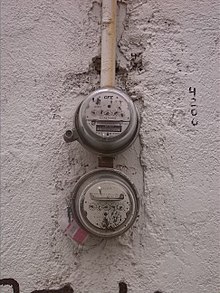Watt hour meter
The watt hour meter, electric meter or electricity meter is a device that measures the consumption of electrical energy of a circuit or an electrical service, being this its specific objective. They are typically calibrated in billing units, the most common being kilowatt-hours [kWh].
There are electromechanical and electronic meters, this being the one currently occupied. Electromechanics use current and voltage windings to create eddy currents in a disc that, under the influence of magnetic fields, produces a rotation that moves the dial's needles. Electronic meters use analog-to-digital converters to do the conversion.
In meters without remote management, the meter is read once per billing period. Smart meters (remote management meters) take advantage of the fact that they are installed in an intelligent electrical network (smart grid) to send consumption data to the distribution company more frequently. As the implementation of smart grids progresses, this will allow a generation that is more adjusted to the real demand of each moment of the day.
Operation
The electromechanical meter uses two sets of coils that produce magnetic fields; these fields act on a disk, (usually aluminum, which is a non-magnetic conductor where parasitic currents are produced). The action of the eddy currents produced by the current coils on the magnetic field of the voltage coils and the action of the eddy currents produced by the voltage coils on the magnetic field of the current coils give a vectorial result such that produces a torque on the disk. The torque is proportional to the power consumed by the circuit.
The disc is supported by magnetic fields and ruby supports to reduce friction, a system of gears transmits the movement of the disc to the needles that count the number of turns of the counter. The higher the power, the faster the disc spins, accumulating more spins as time goes by.
The maximum voltages that electrical meters support are approximately 600 volts, and the maximum currents can be up to 200 amps. When voltages and currents exceed these limits, voltage and current measurement transformers are required. Conversion factors are used to calculate consumption in such cases.
There is a shadow coil that is a little plate which is short-circuited. Said coil has a negligible resistance and therefore a very important current will be generated in it, which, when subjected to a field, will generate a motor torque that will eliminate the coefficient of friction of the gears. The meter will start running with 1% load and between 0.5 leading and lagging power factor.
Internal consumption meters
These are devices that allow measurement of energy used by individual devices. There are a variety of models available on the market today, but they all work on the same basic principle. The meter is plugged into an electrical outlet and the device to be measured plugs into the meter. These devices can help save energy by helping you learn which appliances are consuming the most power, or even if an appliance has a problem and is consuming more power than it should.
Some of the new digital remote management meters allow the connection of a device that transmits to the user the punctual and periodic consumption. This information seeks to make the user aware of the energy they consume.
Fraud and security
The meters can be manipulated so that they register less consumption than the real one, which allows the use of energy without having to pay for it. This theft of electrical fluid is a criminal offense according to different national legislations and, in addition, it can be dangerous.
The replacement of meters by the new equipment with remote management is making it possible to detect many cases of theft of electricity.
When a manipulation is detected, the marketing companies re-invoice the consumption not previously paid. The amount of this rebilling depends on each legislation, but if the unbilled amount cannot be determined, a payment formula of n hours of consumption is applied, per contracted power, for a period of n months of rebilling. For example, in most US states for a price of $0.095/kWh the most common power supply point would be charged $5,000 per month.
Manipulation of meters and other elements of the electrical supply can cause situations of physical danger to people and property, by unprotecting connection elements. Fires occur in concentrations of meters, as well as overvoltage spikes that can damage electrical appliances or even injure people.
Contenido relacionado
Speed motorcycling
Closed source
Stopping distance

